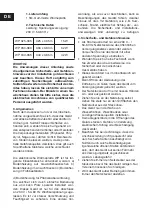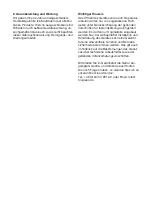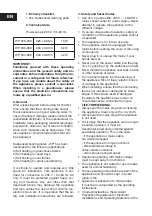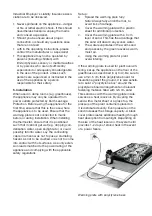
Industrial Employer’s Liability Insurance Asso-
ciation are to be observed.
• Never spill fluids on the appliance – danger
of fire or lethal electric shock. If this should
nevertheless transpire, unplug the mains
and consult a specialist.
• Should you be unsure about proper
connection or should any questions arise
that are not dealt
• with in the operating instructions, please
contact the manufacturer or a specialist.
• This appliance may not be operated by
persons (including children) with
limited physical, sensory or mental faculties
or by persons who are not sufficiently
experienced or adequately knowledgeable
in the use of the product, unless such
persons are supervised or instructed in the
use of the appliance by a person
responsible for their safety.
5. Installation
When used in damp rooms (e.g. greenhouse),
the appliance may only be operated from
power outlets protected by Earth Leakage
Protection. Before using the appliance for the
first time, ensure that this is the case where
the appliance is to be used. Ensure that the
warming plate is not connected to mains
before or during installation. When installing
the thermostat, ensure that it is positioned
such that it cannot get wet (e.g. dripping con-
densation water, open skylight etc.) or could
possibly fall into water. Lay the connecting
cable in a manner as not to pose a stumbling
hazard, as not to be crushed or as not to come
into contact with hot surfaces. Use only exten-
sion leads matched to the power rating of the
appliance and complying with the applicable
safety regulations.
Set up:
a. Spread the warming plate fully.
Note: Always fully unroll the mat, to
avoid risk of damage.
b. Cover the warming plate with a plastic
sheet for additional protection.
c. Cover the warming plate with a 3 cm
layer of sand. This has the advantage that
the sand will absorb any excess water.
d. The water evaporates in the warm sand
and passes by the green leaves as warm,
moist air.
e. Using the warming plate for plant
overwintering:
If the warming plate is used for plant overwin-
tering, set up the appliance on the floor of the
greenhouse as described in a) to d). Be sure to
use a min. 5 cm thick polystyrene board for
insulation against the ground. It is also sensib-
le to build a “polystyrene box” around the
polystyrene board arrangement and relevant
fastening material, filled with 4-5 cm sand.
This sand box with the warming plate inside
serves as a heat reservoir. By covering the
sand with a metal sheet or a glass top, the
pressure of the plant containers placed on
it is distributed evenly. Even pressure on the
sand increases the storage capacity. A black
cover plate creates additional heating through
heat absorption from sunlight. Depending on
the size of the heat reservoir, the system still
provides 1-2 days of stored heat in the event
of a power failure.
Warming plate with polystyrene base


























